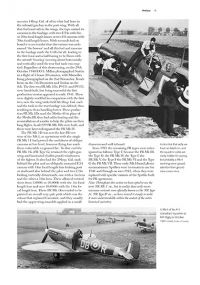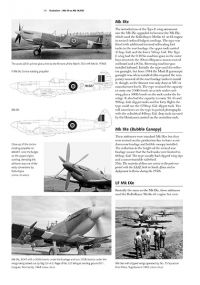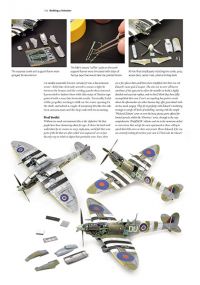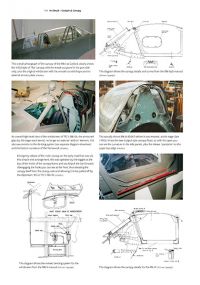Valiant Wings Publishing | Airframe & Miniature 12: The Supermarine Spitfire Part 1
Reviewed by Kevin Futter

UK publisher Valiant Wings Publishing has released Number 12 in its Airframe & Miniature series, entitled The Supermarine Spitfire Part 1 (Merlin-powered) including the Seafire: A Complete Guide to The Famous Fighter. The author is Richard Franks, and the illustrations are shared between Richard Caruana and Wojciech Sankowski. The terrific cover art is by Jerry Boucher.
The first thing that struck me when I picked up this book was how heavy it is; at a massive 240 pages plus a gatefold section of scale drawings, it is indeed a weighty tome. It's extremely well printed on quality glossy paper, and the reproduction of all drawings and photographs is first-class.
The contents are broken up into nine separate chapters, grouped into two distinct sections:
- Airframe Chapters
- Evolution - Mk I to V
- Evolution - Mk VI to IX/XVI
- Evolution - Photo-reconnaissance
- Evolution - Seafire
- Camouflage and Markings and Colour Profiles
- Miniature Chapters
- Spitfire (Merlin-powered) Kits
- Building a Selection
- Building a Collection
- In Detail: The Supermarine Spitfire & Seafire
There is also a preface, along with a collection of appendices at the rear of the book:
- Kit List
- Accessory & Mask List
- Decal List
- Bibliography
The sample images below (courtesy Valiant Wings Publishing) should give a good indication of the nature and style of the book's contents:
While not mentioned in the table of contents, the Preface weighs in at a substantial 30 pages, and describes a potted history of the Merlin-engined Spitfire, which provides useful support for the subsequent technical information.
Additionally, there is a further 21 pages covering the Merlin-engined Spitfire's use in foreign service, as part of a 48-page downloadable PDF, available from the Valiant Wings website. That is a terrific piece of value-add!
The sequence of chapters covering the evolution of the airframe spans 35 pages, and consist of brief summaries supported by crisply-rendered greyscale profile drawings. They are clear and easy to follow, and form a handy guide for discerning what features distinguished which variants.
The Camouflage & Markings section covers 40 pages, and includes a four-view stencil placement guide, based on the Mk IX airframe. Rather than a dedicated section for colour profiles, they are instead interspersed throughout the text as necessary. They are by Richard Caruana as usual, and are very nicely rendered indeed. A set of profiles for aircraft in foreign service is also provided.
Chapter 6 features a brief description of the commonly available Merlin-powered Spitfire and Seafire model kits. In 1/32 scale, the HobbyBoss Mk V, Revell Mk IXc, and Tamiya family of kits all receive extensive coverage, while in 1/24 scale, only the Trumpeter Mk V and VI kits are dealt with.
The modelling section features four kit builds, comprising 1/72 Airfix Mk II and Eduard Mk IXe by Libor Jekl, 1/48 Eduard Mk IXe by Steve Evans, and 1/32 Tamiya Mk IXc by Dani Zamarbide. These builds are extremely well done, and will serve as inspiration and guidance for our own Spitfire builds when we get to them.
Chapter 8 is called Building a Collection, and features a series of annotated isometric 3D line drawings by Wojciech Sankowski. These are designed to illustrate the salient differences between the various prototype and pre-production airframes as the series developed, and form a perfect companion to the earlier 'evolution' chapters.
Chapter 9, In Detail, features an extensive selections of photographs and diagrams, including a series of walkaround detail photos of surviving airframes. The walkaround photos have been selected with a modeller's eye, which is not only welcome, but very handy.
The four appendices cover the usual list of available kits, aftermarket, decals, and mask sets, as well as a concise bibliography for further research.
At the very back of the book, secured inside the rear cover, is a set of 1/48 scale plans in gatefold format. These are printed on heavy, non-glossy plain stock, and cover the following airframes:
- Spitfire Mk I
- Spitfire Mk Ia
- Spitfire Mk Ib
- Spitfire PR Mk Ic
- Spitfire PR Mk IVtrop
- Spitfire Mk Va
- Spitfire Mk Vb
- Spitfire Mk Vc
- Spitfire HF Mk VI
- Spitfire Mk VIII
- Spitfire Mk Va
- Spitfire Mk IXc
- Spitfire Mk IXe
- Spitfire PR Mk X
- Spitfire PR Mk XI
- Seafire Mk Ib
- Seafire LR Mk II
- Seafire Mk III
- Spitfire LF Mk XVIe
These are drawn by Richard Caruana and look very nicely done. Only the Spitfire Mk I, Mk V, Mk IXc, and Seafire Mk III airframes are given full four-view treatment. The other listed types are shown as fuselage profile views, which is sufficient to elucidate the pertinent differences in most cases.
Conclusion
Not being a Spitfire expert, I can't give a considered evaluation of the accuracy or veracity of the text itself, and so will leave that to more knowledgeable readers. All other elements of the book ooze quality however, from the clear photography to the beautiful profiles and the detailed scale plans. Contemporary photographs are plentiful and very nicely reproduced. Overall it's an impressive attempt to be the Complete Guide the title alludes to. Recommended!
Thanks to Valiant Wings Publishing for the review copy.
© Kevin Futter 2018
This review was published on Wednesday, September 19 2018; Last modified on Friday, September 13 2019






